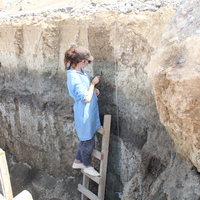Papers by Istvan Galambos
AGUSM, May 1, 2001
This paper is based on the preliminary results of an IIASA-based study of flood-risk management f... more This paper is based on the preliminary results of an IIASA-based study of flood-risk management for the Hungarian Upper Tisza River, where recent devastating floods have been exacerbated by cyanide and heavy metal pollution episodes originating in Romania. Hungary ranks only behind countries like Bangladesh and the Netherlands with regard to the extent of its territory exposed to flood risks,

This work is devoted to investigation of the flow interaction between above and below ground drai... more This work is devoted to investigation of the flow interaction between above and below ground drainage systems through gullies. Nowadays frequent flood events reinforce the need for using accurate models to simulate flooding and help urban drainage engineers. A source of uncertainty in these models is the lack of understanding of the complex interactions between the above and below ground drainage systems. The work is divided into two distinct parts. The first one focuses on the development of the solution method. The method is based on the unstructured, two-and three-dimensional finite volume method using the Volume of Fluid (VOF) surface capturing technique. A novel method used to link the 3D and 2D domains is developed in order to reduce the simulation time. The second part concentrates on the validation and implementation of the Computational Fluid Dynamics (CFD) model. The simulation results have been compared against 1:1 scale experimental tests. The agreement between the predictions and the experimental data is found to be satisfactory. The CFD simulation of the different flow configurations for a gully provides a detailed insight into the dynamics of the flow. The computational results provide all the flow details which are inaccessible by present experimental techniques and they are used to prove theoretical assumptions which are important for flood modelling and gully design.
Water Science and Technology, Feb 1, 2013

Multinational Finance Journal, Dec 1, 2003
The main goal of this paper is to develop a flood management model that takes into account the sp... more The main goal of this paper is to develop a flood management model that takes into account the specifics of catastrophic risk management: highly mutually dependent losses, the lack of information, the need for long-term perspectives and explicit analyses of spatial and temporal heterogeneities of various agents such as individuals, governments, and insurers. We use modified data from a pilot region of the Upper Tisza river, Hungary, to illustrate the evaluation of a public multi-pillar flood loss-spreading program involving partial compensation to flood victims by the central government, the pooling of risks through a mandatory public catastrophe insurance on the basis of location-specific exposures, and the demand for a contingent ex-ante credit to reinsure the insurance's liabilities. GIS-based catastrophe models and stochastic optimization methods are used to guide policy analysis with respect to location-specific risk exposures. We use economically sound risk indicators leading to convex stochastic optimization problems strongly connected with nonconvex insolvency constraint, VaR and CVaR (JEL G22, G28, C61).
Springer eBooks, Oct 30, 2012
This chapter summarizes studies on the development of a financial risk management model for flood... more This chapter summarizes studies on the development of a financial risk management model for floods in the Upper Tisza river region, Hungary. We focus on the evaluation of a multi-pillar flood loss-spreading program involving partial compensation to flood victims by the central government, the pooling of risks through a mandatory public-private insurance on the basis of location-specific exposures, and a contingent ex-ante credit to reinsure the pool’s liabilities. Policy analysis is guided by GIS-based catastrophe models and stochastic optimization methods with respect to location-specific risk exposures. We use economically sound risk indicators leading to convex stochastic optimization problems strongly connected with non-convex insolvency constraint and Conditional Value-at-Risk (CVaR).
The Proceedings of …, 2001
The main goal of this paper is to develop a flood management model that takes into account the sp... more The main goal of this paper is to develop a flood management model that takes into account the specifics of catastrophic risk management: highly mutually dependent losses, the lack of information, the need for long-term perspectives and explicit analyses of spatial and ...
This paper is based on the preliminary results of an IIASA-based study of flood-risk management f... more This paper is based on the preliminary results of an IIASA-based study of flood-risk management for the Hungarian Upper Tisza River, where recent devastating floods have been exacerbated by cyanide and heavy metal pollution episodes originating in Romania. Hungary ranks only behind countries like Bangladesh and the Netherlands with regard to the extent of its territory exposed to flood risks,
A System Analytical Approach, 2000
Computational Fluid Dynamics (CFD) is likely to play an increasing role in Urban Water Management... more Computational Fluid Dynamics (CFD) is likely to play an increasing role in Urban Water Management modelling. It provides the opportunity to perform detailed modelling, both predictive and analytic, of increasingly complex elements of the urban water infrastructure. This can include modelling of flow control devices, separators and other flow processing elements, and also the interaction of the infrastructure with the environment, such as road runoff. As available computing power has increased, more complex and ...

Multinational Finance Journal, 2003
The main goal of this paper is to develop a flood management model that takes into account the sp... more The main goal of this paper is to develop a flood management model that takes into account the specifics of catastrophic risk management: highly mutually dependent losses, the lack of information, the need for long-term perspectives and explicit analyses of spatial and temporal heterogeneities of various agents such as individuals, governments, and insurers. We use modified data from a pilot region of the Upper Tisza river, Hungary, to illustrate the evaluation of a public multi-pillar flood loss-spreading program involving partial compensation to flood victims by the central government, the pooling of risks through a mandatory public catastrophe insurance on the basis of location-specific exposures, and the demand for a contingent ex-ante credit to reinsure the insurance's liabilities. GIS-based catastrophe models and stochastic optimization methods are used to guide policy analysis with respect to location-specific risk exposures. We use economically sound risk indicators leading to convex stochastic optimization problems strongly connected with nonconvex insolvency constraint, VaR and CVaR (JEL G22, G28, C61).

Water Science & Technology
This paper presents the results of the experimental and numerical investigation of interactions b... more This paper presents the results of the experimental and numerical investigation of interactions between surface flood flow in urban areas and the flow in below ground drainage systems (sewer pipes and manholes). An experimental rig has been set up at the Water Engineering Laboratory at the University of Sheffield. It consists of a full scale gully structure with inlet grating, which connects the 8 m(2) surface area with the pipe underneath that can function as an outfall and is also further connected to a tank so that it can come under surcharging conditions and cause outflow from the gully. A three-dimensional CFD (Computational Fluid Dynamics) model has been set up to investigate the hydraulic performance of this type of gully inlet during the interactions between surface flood flow and surcharged pipe flow. Preliminary results show that the numerical model can replicate various complex 3D flow features observed in laboratory conditions. This agreement is overall better in the cas...
Within the dual drainage framework, flooding can be modelled either as flow in a network of one-d... more Within the dual drainage framework, flooding can be modelled either as flow in a network of one-dimensional (1D) open channels and ponds, or as a 2D flow with depth-averaged velocities, or as a 3D computational domain. Each approach has its advantages and drawbacks, thus there is no single 'best' choice of the dimensionality of surface flow. In addition, every model - be it 1D, 2D or 3D - involves specific problems related to: spatial resolution and generation of computational mesh, treatment of buildings and terrain features, sub-surface/surface interactions, communication of results etc. Therefore we can only talk about an adequate approach because it very much depends on the extent of the area, quality of available data, purpose and type of the analysis i.e. the required number of off-line or real-time runs and other factors.
Advances in Natural and Technological Hazards Research, 2012

Water Science and Technology, 1999
Water quality management has been a priority in Hungary 10 the past decades. Focus was especIally... more Water quality management has been a priority in Hungary 10 the past decades. Focus was especIally upon improving water supply and sllmulatmg economic development. On 1st January 1996 new Law on General Regulations for Environmental ProtectIOn (No. 53/1995) and the Act on Water Management (No. 57/1995) came into force. These laws are framework laws providmg objectives to the development of the legalmstrumentatlon of environmental and water protection. These new regulations should reflect the transitional nal1lre of Hungary and should stimulate and facilitate the use of the most cost-effective and efficient forms of water quality management. Furthermore the regulations should aim at harmonization with EC directives. To support the elaboration of the new regulations case studies were carried out in the frame ofa EU PHARE financed project to give answers to several water quahty management and economic questions, such as (a) the way in which water quahty objectives can be set when dealing WIth transboundary loads and vulnerable groundwater resources; (b) how to address industnes In sanitation; (c) how to formulate collection and treatment requitements 10 the case of a very sensitive surface water originating in a river basin wllh predominantly non-vulnerable groundwater resources; (d) the cost effective sanitation strategy; (e) the determination of permissible loads by using water quality models; and (1) how to allocate this load among pollution sources. The paper is gives an overview of the case study with the discussion of the conclusions.
Within the dual drainage framework, flooding can be modeled either as flow in a network of one-di... more Within the dual drainage framework, flooding can be modeled either as flow in a network of one-dimensional (1D) open channels and ponds, or as a 2D flow with depth-averaged velocities, or as a 3D computational domain. Each approach has its advantages and ...

Water science and technology : a journal of the International Association on Water Pollution Research, 2013
This paper presents the results of the experimental and numerical investigation of interactions b... more This paper presents the results of the experimental and numerical investigation of interactions between surface flood flow in urban areas and the flow in below ground drainage systems (sewer pipes and manholes). An experimental rig has been set up at the Water Engineering Laboratory at the University of Sheffield. It consists of a full scale gully structure with inlet grating, which connects the 8 m(2) surface area with the pipe underneath that can function as an outfall and is also further connected to a tank so that it can come under surcharging conditions and cause outflow from the gully. A three-dimensional CFD (Computational Fluid Dynamics) model has been set up to investigate the hydraulic performance of this type of gully inlet during the interactions between surface flood flow and surcharged pipe flow. Preliminary results show that the numerical model can replicate various complex 3D flow features observed in laboratory conditions. This agreement is overall better in the cas...











Uploads
Papers by Istvan Galambos